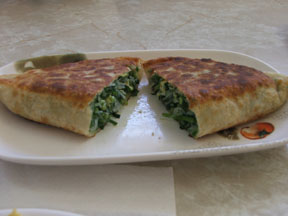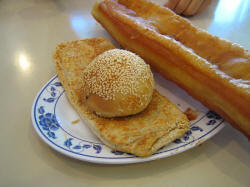Chinese Culture >> Chinese Food Articles >> Taiwanese Breakfast
Authentic Taiwanese Breakfast
Quick, name a few dishes on the Chinese lunch or dinner menu.
Easy, right? Sweet and sour pork. Stir-fried rice. Won ton soup. Kung pao
chicken. Peking duck.
Now, what's a Chinese breakfast like? Having trouble? No worries. The cuisine
has yet to go mainstream in the morning outside of China. And that's a pity
because there's a wonderful array of Chinese breakfast fare—steamed bread,
stuffed buns and simple egg dishes. Here, the woks don't get fired until the
lunch rush.
The early morning food is little known elsewhere partly because some diners may
hesitate to take gastronomic risks shortly after waking up. They're groggy,
stomachs are tender and they might be running late, with no time for culinary
adventure.
Perhaps visitors fear they'll get surprised with a generous serving of fish
heads and pig intestines bobbing in a bowl of watery rice porridge. No doubt,
this would be a delightful way to start the day for many people. But others
would rather stick to the trusty plate of scrambled eggs and toast with coffee
and orange juice.
But if travelers know where to look for the food and how to order it, they can
find a variety of dishes that are friendly to Western tastes and even closely
related to what's eaten at home.
One great place to sample Chinese breakfast food is Taiwan. The tiny leaf-shaped
island off China's southern coast is one of the world's best places for
fantastic Chinese food. And the cooking starts at sunrise on almost every block
in residential areas in the island's densely populated cities.
Step out of the hotel and start roaming the back alleys. Listen for the sound of
spoons beating eggs in a plastic bowl or steel spatulas scraping a skillet or
clanging in a wok. Sniff for the scent of sizzling eggs.
The best places to look for breakfast shops are near subway stations, where the
food is hurriedly snarfed up by what's known in Taiwanese slang as the "shangban
zu," or the "commuting tribe."
 Some
places should be avoided by travelers who would rather wade than plunge into the
local cuisine. Many noodle stands tend to go heavy on the organ meats. And there
are shops—usually with bright orange, red and yellow signs—that specialize in
cheap grilled egg sandwiches filled with greasy Spam-like meat on bland white
bread.
Some
places should be avoided by travelers who would rather wade than plunge into the
local cuisine. Many noodle stands tend to go heavy on the organ meats. And there
are shops—usually with bright orange, red and yellow signs—that specialize in
cheap grilled egg sandwiches filled with greasy Spam-like meat on bland white
bread.
The best places put their kitchens by the entrance so customers can be sure the
food is freshly prepared. Look for tall towers of bamboo steamers full of hot
dumplings and buns. There should also be on display a cluster of "you tiao,"
(pronounced YO TEE-YAU) foot-long pieces of dough deep fried until it's dark
brown.
Menus won't likely be in English because foreign customers are so rare. The
shop's offerings are often listed in Chinese characters on a sign mounted on the
wall. This shouldn't be a problem because most of the food should be on display
and diners can point to what they want.
The Ying Family Soybean Milk shop—a block away from the Chihshan subway station
in northern Taipei—is a classic greasy chopstick breakfast spot. The setup is
simple: chipped but clean Formica-topped tables, a wooden counter where food is
ordered, three women in matching red-checked gingham head scarves who cheerfully
greet customers and serve up food seconds after it's ordered.
A glass case is full of "shao bing" (pronounced SHAU BING)—long baked buns
covered in toasted sesame seeds. The buns are usually split open and filled with
a fried egg or a "you tiao," which literally means "grease stick." Sometimes
"you tiao" is translated as "crullers," but the fried dough is tougher and
chewier than the standard doughnut, and not as sweet.
The Ying Family shop also serves up "dan bing," (pronounced DAHN BING) or egg
pancakes. They're made by beating an egg, tossing in some chopped green onions
and frying the egg on a sizzling griddle. Just as the egg becomes firm, a flour
tortilla-like pancake is tossed on top of the egg. It gets flipped over a few
times before it's folded, chopped up and plated. It's seasoned with a splash of
soy sauce or a dollop of chili sauce.
Another breakfast staple is "man tou," (pronounced MAHN TOW) or steamed bread.
Ovens weren't common in China, so most buns or rolls were cooked in steamers.
Man tous are usually the size of a fist and have a light, chewy and spongy
texture. They can be eaten alone or split open and used for egg sandwiches.
Steamed buns, or "baozi" (pronounced BAO ZEH), are also tasty and come stuffed
with spicy pork or vegetables. The Ying Family Shop's baozi are filled with
chopped cabbage, carrots and black mushrooms. Dipped in a puddle of soy sauce,
the buns are a light, healthy breakfast.
Most of the menu items cost between 50 cents and $1.
One curious thing about breakfast eateries is that coffee and tea aren't
traditionally served. People usually drink the beverages at home or at the
office. Fruit also isn't eaten at breakfast, although a fantastic selection of
fruit is available in Taiwan.
A classic breakfast drink in Taiwan is "dou jiang," (pronounced DOUGH JEE-YANG)
or soybean milk. It can be an acquired taste and might seem watery and chalky at
first compared to milk, but even in Western countries, it is growing in
popularity, thanks in part to a reputation as a high-protein alternative to
dairy.
Soybean milk is served in a small cereal bowl with a Chinese-style wide scoop
spoon. People can choose between hot or cold and sweet and salty versions. Some
breakfast stands sell yellow sponge cake, sometimes called "ma la gao,"
(pronounced MAH LAH GAU) that pairs well with dou jiang.
One of the great pleasures of eating breakfast in Taiwan is to get a hot bowl of
soybean milk on a cold winter morning. Allow the steam from the soybean milk to
bathe your face as you slurp up the drink and dunk thick slices of sponge cake
into the dou jiang.
Street vendors peddle all sorts of breakfast food, too. They also set up near
busy bus and subway stations, and they appear to do big business with women, who
usually get stuck taking mass transit while their husbands commute in the family
car.
 Some
stands just involve a man frying globs of dough in a huge wok filled with oil
and set over a propane gas burner on the sidewalk. Others
pull a cart with a small assembly line to make "fan tuan," (pronounced FAHN
TWAHN) or rice roll-ups.
Some
stands just involve a man frying globs of dough in a huge wok filled with oil
and set over a propane gas burner on the sidewalk. Others
pull a cart with a small assembly line to make "fan tuan," (pronounced FAHN
TWAHN) or rice roll-ups.
The fan tuan makers scoop out a handful of sticky glutinous rice from a wooden
bucket and pat it down into a square on a piece of plastic wrap. Spoonfuls and
pinches of pickled mustard leaves, fried ground pork, crispy you tiao and other
ingredients lined up in plastic bowls are sprinkled on top of the bed of rice.
Then it gets rolled up into a rice tamale or burrito and sold to secretaries who
eat it at the office.
Sampling what Chinese cuisine has cooking for breakfast doesn't take a lot of
money, time or effort. It does require conquering the common trepidations about
crossing cultural boundaries in the morning. But once these are overcome, the
rewards are quick to follow.
(Contributed by AP)
